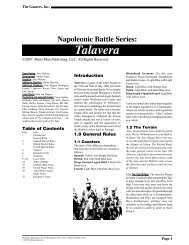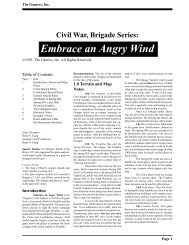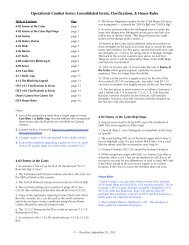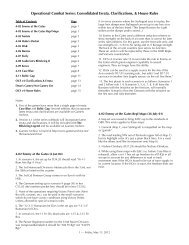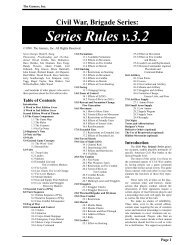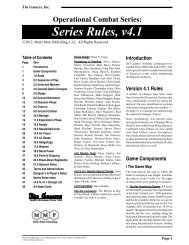Seven Pines Specific Rules - MMP Gamers Archive
Seven Pines Specific Rules - MMP Gamers Archive
Seven Pines Specific Rules - MMP Gamers Archive
Create successful ePaper yourself
Turn your PDF publications into a flip-book with our unique Google optimized e-Paper software.
The <strong>Gamers</strong>, Inc.fully developed. The problem was thatwhile Sumner’s Federals did project muchfurther east than did the dented lines of the3rd and 4th Corps, the Union 2nd Corpswas still fresh and very strong. Worse, anydrive north by Longstreet would expose hisflank to the Federal 3rd Corps which wasstill effective.However, Longstreet’s solution to thisconundrum was not a good one. He simplyignored Smith, and placed the bulk of theattack once again on Hill, who sent forwardthree brigades (none from his own division,which was pretty badly beaten up by theprevious day’s fighting) in a probing attackthat was mainly directed west instead ofnorth. When these three brigades faltered,more men were committed, but fed intoaction piecemeal. In the end, Longstreetcommitted six brigades—four of his ownand two from Huger—into a series of frontalattacks on the Union 3rd Corps, but theFederals were not driven an inch. Smithheard the fighting, but elected not to commitWhiting’s men, and by midday the actionwas over.The final act in the drama was asignificant one. At 2:00 p.m., PresidentDavis and his entourage rode up to Smith’sHQ on the Nine Mile Road, where Smithwas informed that he was being relieved,and that Davis’ advisor, General Robert E.Lee, was assuming command of the army.With little fanfare, Smith handed overcommand; he would resign in Novemberof that year, and ended the war commandingthe Georgia State Troops in the Atlantacampaign.As can be imagined, the recriminationsover what went wrong at <strong>Seven</strong> <strong>Pines</strong> weremassive. Longstreet’s report blamed Hugerfor the mix-up at Gillie’s Creek, andJohnston accepted much of this in his ownreport, despite it being clearly at odds withhis own battle plans for the 31st. Huger, forhis part, did not see either Longstreet’s orJohnston’s reports until much later, andonce he did spent much of his post-warcareer trying to absolve himself of blame,mostly by attacking Longstreet. Smith alsospent much time attacking Longstreet forthe aborted effort on June 1st, ultimatelyblaming the latter general for most of whatwent wrong on that day as well.The truth is likely beyond reach.Certainly Longstreet took the wrong road,and his criticism of Huger seems misplaced.The darker view of Longstreet has himdeliberately sabotaging Johnston to advancehis own career visibility, and setting upHuger to take the blame once things wentbadly. However, none of this explains awaythe central problem of this theory: namely,that Johnston acquiesced to much ofLongstreet’s view of what happened in hisown report. I feel the real reason is somewhatless sinister: Longstreet was genuinelyconfused about the route, quite possiblegiven that it was one of the attackpossibilities debated prior to the fight.Johnston’s orders were manifestly unclear,as evidenced by Huger’s own report onthem, and the lack of written orders at allsimply makes the possibility of confusioneven more likely.Even the most sympatheticexplanation of Longstreet’s actions,however, cannot escape the fact that thetwo days of <strong>Seven</strong> <strong>Pines</strong> were a blot on hisrecord, marked by confusion and poortactical thinking, and his treatment of Hugerwas shabby. Worse, Longstreet seems tohave decided simply to ignore Smith’sdirect order for the June 1st attack, withonly a very limited commitment of forceson the second day. Had Longstreet turnedin a similar performance a month later,during the <strong>Seven</strong> Days, there can be littlequestion that he, along with Huger andMagruder, would have been sent off tointernal exile in some remote post.However, the reality is that Longstreet’sactions during the <strong>Seven</strong> Days were almostthe antithesis of his <strong>Seven</strong> <strong>Pines</strong>performance: solid, responsive, anddisplaying a great deal of tactical control inseveral actions. Whatever else it was, <strong>Seven</strong><strong>Pines</strong> was a learning experience forLongstreet.Designer’s NotesThe most interesting aspect of <strong>Seven</strong><strong>Pines</strong> is how badly the attack was actuallyrun. I wanted to create a game that wouldgive the player some idea of just howconfused the Confederate side was, and thedifficulties inherent in orchestrating a morecoherent attack out of the mess in place onthe morning of May 31st, 1862. I think thatthe historical scenarios recreate that puzzleas well as any boardgame can.On the other hand, the basic plan wasquite sound, and Johnston did see a realopportunity. I think the contrast betweenthe actual situation and the plan as intendedare quite striking, and bode ill for the Federalwho has to play that one out. I’m pleasedthat this game offers such a detailed look atthis battle, since it has been largely lost tohistory and wargaming alike, usuallyglossed over as an abortive prelude to the<strong>Seven</strong> Days. For those of you who claimthat we never offer up the obscure, orcomplain about the umpteenth iteration ofGettysburg: here is a chance to spend sometime with the largest unknown battle of thewar.Longstreet also provides an interestingproblem here. Over the years, a number ofgamers have asked me how I would dealwith Longstreet at <strong>Seven</strong> <strong>Pines</strong>. It would behard to argue that he was anything otherthan a “Zero” in game terms, certainly Ihave no compunctions about doing so here.I have always tried to limit the evaluationof leadership values to the battle in question:hence ratings for Jackson, for example,that vary between zero and four from gameto game. Longstreet fumbled badly here,and was rated accordingly. A month later,of course, he was doing well, and his <strong>Seven</strong>Days’ ratings reflect that. I’m not sure I canfully explain the inherent schizophreniahere, but I can justify it in game terms.Students of the battle might well notice afew discrepancies. Featherston’sConfederate Brigade was really led by G.B. Anderson; Featherston was ill. However,I already had enough Andersons runningaround, I left Featherston’s name on theunit to help reduce confusion. Alternatively,I left R. A. Anderson in command ofLongstreet’s Division, despite the fact thatthis, too, was only a temporary promotion:Longstreet made a point of leavingAnderson in charge and commanding onlythe wing, and I wanted to simplify thecommand situation here. The alternativewas to add rules leaving Longstreet incommand of both, or using (and noting ineach case) a Repl leader. Neither solutionwas very clean, so I simply accepted thesituation as is.There is one other aspect ofConfederate command that was a problem:demi-divisions. G. W. Smith’s wing wasactually divided into demi-divisions, wherea brigade commander would take commandof his and a couple of other brigades, on afairly informal basis. The main problemwith following this practice in the game isthat it conferred substantial—andunrealistic—advantages to the Confederateplayer in the form of more leaders forcombat and morale purposes. In reality,these formations did not work well, and Ididn’t want to reward the player for anunsuccessful mechanic. I prefer that theplayer deal with the larger, morecumbersome formations.The Union army is much easier to dealwith here, since it exists in a formal Corpsstructure. The only significant absence isthe army commander, a situation bound tobe familiar to those of you who have beenplaying the <strong>Seven</strong> Days’ Scenarios.McClellan was somewhat indisposed, andnever set foot over the river for the battle,Page 23



